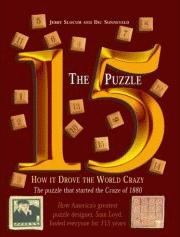The 15 Puzzle
|

|
Until very recently, the 15 Puzzle had almost everything that makes a puzzle a human adventure and a memorable human heritage item.
It is simple: the rules can be explained to a toddler. When it appeared in 1879 as The Gem Puzzle, the 15 Puzzle was accompanied by a cryptic instruction: Place the blocks in the box irregularly, then move until in regular order.
It has an exciting history: no other puzzle in history (not the famous Rubik's cube, nor the more recent Sudoku) spread across America and the rest of the world at such speed and arose such a wave of passion bordering on mass craze.
It has a variety: the number of possible configurations is tremendous and, in addition, the original numbers can be replaced with pieces of a picture or letters that comprise a meaningful sentence.
There is an exciting piece of mathematics behind it: the theory of permutations - transpositions and inversions - sheds light on solvability of any particular configuration. The theory leads to a more general playground of puzzles on graphs.
The puzzle expands one's imagination: it is usually played on a flat surface. It can be placed on a cylinder or even a Möbius strip without changing the rules, but adding a degree of excitement.
It has a distinguished pedigree: the attribution is built right into its common name. To many the puzzle is known as Sam Loyd's Fifteen, being an invention of the most prolific and most famous of all American puzzlists, the famous Sam Loyd.
A new book by Jerry Slocum and Dic Sonneveld adds intrigue to the picture: as the authors have found, Sam Loyd has not invented the puzzle, but managed to fool the contemporaries and the following generations into believing otherwise. It took five quarters of a century for the truth to be revealed. By painstakingly wading through thousands of newspapers found in dozens of locations throughout the United States and Europe, the authors uncovered the true origins of the puzzle and its winding itinerary to the market and into the history.
The book itself is of the gift quality, well written and exquisitely illustrated. The text is authenticated with photographs and newspaper clips. Interspersed among bits and pieces related to the puzzle, many illustrations build up the historic background and help recreate and sense the cultural atmosphere of the last two decades of the 19th century.
The book is comprehensive. The first chapter of 50 pages (the largest in the book) follows the puzzle for a few months from its appearance in December 1879 through the beginning of the craze in February 1880 through its unstoppable spread from coast to coast by March 1880. The timeline of the craze has been documented and summarized in three tables (puzzle first appearance by city, puzzle ads in national periodicals, international ads and articles). The text highlights the entries with additional details.
The first chapter also documents the early attempts at the solution of the puzzle.
This follows by the review of the puzzle literature (Chapter 2) and research into the origins of the puzzle (Chapters 3-6). The quality of the scholarly research is next to impeccable; its significance is overwhelming.
Chapter 7 presents the theory of the puzzle from three different angles. Chapter 8 complements the first chapter with a fascinating collection of comic poems devoted to the puzzle and newspaper stories from around the world. Were Solvers of the Fifteen Puzzle Driven Insane? Oh, yes. Many indeed were. An endearing collection of newspaper clips leaves little doubt of the often fatal effect the puzzle had on human minds. As an example that also points at the extent of the interest in the puzzle, from the Bangor Daily Whig and Courier (Maine):
George Mitchell, a painter, was arrested last night in San Francisco. He had become insane over the 'fifteen' puzzle and covered the floor and walls with figures in the attempt to solve it.
Chapter 9 describes the lasting impact the Fifteen Puzzle had on the puzzle making industry.
The book will be of keen interest to a puzzle lover, a student of the late 19th century history and anybody fascinated with psychology of popular delusions. It is a bewitching sequel to Charles Mackay's rarity.
The 15 Puzzle, J. Slocum and D. Sonneveld, Hardcover, 144 pp, $30.00. ISBN 1-890980-15-3.
|Up| |Contact| |Front page| |Contents| |Store|
Copyright © 1996-2018 Alexander Bogomolny73342852
